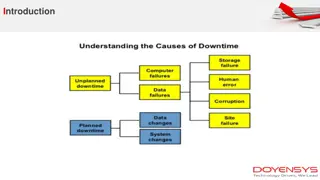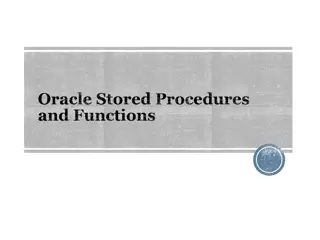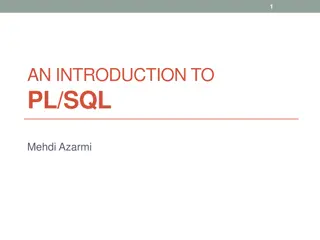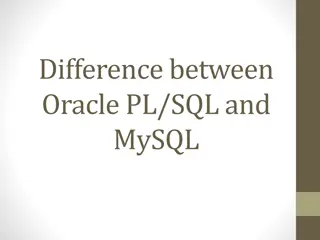RDBMS WITH ORACLE
Mrs. S. Cephas, an Assistant Professor in the Department of Computer Science at Sarah Tucker College Palayamkottai, delves into the realm of RDBMS with Oracle. Learn about the intricacies of database management systems, focusing on Oracle's features, functionalities, and applications. Enhance your understanding of how relational databases work and their significance in the digital age. Gain insights into the integration of Oracle databases in real-world scenarios and the practical implications for computer science students. Explore the dynamic world of data management with this comprehensive study guide.
Download Presentation

Please find below an Image/Link to download the presentation.
The content on the website is provided AS IS for your information and personal use only. It may not be sold, licensed, or shared on other websites without obtaining consent from the author.If you encounter any issues during the download, it is possible that the publisher has removed the file from their server.
You are allowed to download the files provided on this website for personal or commercial use, subject to the condition that they are used lawfully. All files are the property of their respective owners.
The content on the website is provided AS IS for your information and personal use only. It may not be sold, licensed, or shared on other websites without obtaining consent from the author.
E N D
Presentation Transcript
RDBMS WITH ORACLE By Mrs.S.Cephas Assistant Professor Department of Computer Science Sarah Tucker College Palayamkottai - 7
Data Definition Language WITH GOD EVERYTHING IS POSSIBLE
Data Definition Language Naming Rules and Conventions A table is an object that can store data in an Oracle database. When you create a table, you must specify the table name, the name of each column, the data type of each column, and the size of each column. The table and column names can be up to 30 characters long. It is possible to have a table name that is only one character long. In naming table and column, letters(A- Z, a-z), numbers(0-9) and special characters - $(dollar sign), _(underscore), and # (pound) are allowed. 3
The table or column name, however, must begin with a letter. The names are not case sensitive, although Oracle stores all object names in uppercase in its data dictionary. Spaces and hyphens are not allowed in a table or a column. It is always a good practice to create short but meaningful names. Table name must be unique in a schema or user account Valid Names Invalid Names STUDENT STUDENT_COURSE_REGISTRATION_TABLE MAJOR_CODE MAJOR CODE X CREATE PROJECT2000 PROJECT****2000 STUDENT#REG #STUDENT Valid/invalid table and column names 4
Data Types When a table is created , each column in the table is assigned a data type A data type specifies the type of data that will be stored in that column. By providing a data type for a column, the wrong kinds of data are prevented from being stored in the column Give any example Varchar2 The VARCHAR2 type is a character data type to store variable-length alphanumeric data in a column. The default and minimum size is one character. The maximum allowable size is 4000 characters in oracle9i. The size is specified within parentheses for example, varchar2(20). If the data are smaller than the specified size, only the data value is stored, and trailing spaces are not added to the value. If a value longer than the specified size is entered, however an error is generated . The longer values are not truncated. 5
In oracle 9i, the VARCHAR2 data type can also take CHAR or BYTE parameters. For example, VARCHAR2(10 byte) is same as VARCHAR2(10) Because byte is the default. If VARCHAR2(10 char) is used , each char may take up1 to 4 bytes. Char The CHAR type is a character data type to store fixed-length alphanumeric data in a column. The default and minimum size is one character. The maximum allowable size is 2000 characters in oracle9i. The size is specified within parentheses for example, char(20). If the data are smaller than the specified size is entered , trailing spaces are added to make its length equal to the specified length. If a value longer than the specified size an error occurs. The CHAR type is appropriated for fixed length values. For example PHONE , SOCIAL_SECURITY_NUMBER 6
The CHAR data types uses the storage more efficiently and processes data faster than the VARCHAR2 type. In oracle 9i, the CHAR data type can also take CHAR or BYTE parameters. For example, CHAR(10 byte) is same as CHAR(10) Because byte is the default. If CHAR(10 char) is used , each char may take up1 to 4 bytes. Number The NUMBER data type is used to store negative , positive , integer , fixed-decimal and floating-point numbers. The NUMBER data type is used for any column that is going to be employed in mathematical calculations for ex SALARY , COMMISSION or PRICE. Precision and Scale - When a NUMBER type is used for a column , its precision and scale can be specified . for example NUMBER(4,2) Precision is the total number of significant digits in the number , both to the left and to the right of the decimal point. Scale is the total number of digits to the right of the decimal point. The Precision can range from 1 to 38.The Scale can range from -84 to 127 7
An Integer is a whole number without any decimal part. To define a column with integer values, only the scale size is provided. For ex employeeid in the Employee table has only 3 values, then NUMBER(3) A fixed-point decimal number has a specific number of digits to the right of the decimal point. The PRICE column has values in dollars and cents, which requires two decimal places For example NUMBER(4,2) ,It will allow a maximum price of 99.99 A floating-point decimal number has a variable number of decimal places. The decimal point may appear after any number of digits. To define such a column , do not specify the scale or precision along with the NUMBER type. For example TAXRATE,INTEREST_RATE columns .. 8
Date Date The DATE data type is used for storing date and time values. The range of allowable dates is between January 1 , 4712 B.C and December 31 , 9999 A.D . The day , month , century , hour, minute and second are stored in the DATE type column. There is no need to specify size. The default date format is DD-MON-YYYY DD Day of a month MON month s first three letters (capitalized) YYYY four digits of the year To use any other format to enter a date value, you are required to use the TO_DATE function . The default time format is HH:MM:SS A.M., representing hours , minutes , and seconds in a 12-hour time format. Long The LONG data type is used for variable-length character data up to 2 gigabytes . There can be only one LONG type column in a table. No need to specify its size . It is used to store a memo, invoice.. 9
NCHAR The NCHAR type is similar to CHAR but uses 2-bytebinary encoding for each character. The NCHAR type is useful for character sets such as Japanese Kanji, which has thousands of different characters. CLOB The Character Large Object data type is used to store single-byte character data up to 4 gigabytes BLOB The Binary Large Object data type is used to store binary data up to 4 gigabytes. NCLOB The Character Large Object data type is uses 2-byte character codes. BFILE The Binary File type stores references to a binary file that is external to the database and is maintained by the operating system s file system. ROWID For unique row address in hexadecimal format. 10
RAW(size) or LONG_RAW. RAW is a data type used to store binary data, or data which is byte oriented (for example, graphics or audio files). One of the most important things to note about RAW data is that it can only be queried or inserted; RAW data cannot be manipulated. RAW data is always returned as a hexadecimal character value. 11
Data Type Use VARCHAR2(size) Variable-length character data: 1 to 4000 characters CHAR(size) Fixed-length character data: 1 to 2000 characters NUMBER(p) Integer values NUMBER(p,s) Fixed-point decimal values NUMBER Floating-point decimal values DATE Date and Time values LONG variable-length character data up to 2 gigabytes . NCHAR similar to CHAR but uses 2-byte binary encoding. BLOB binary data up to 4 gigabytes. CLOB single-byte character data up to 4 gigabytes NCLOB Similar to CLOB :supports 2 byte encoding BFILE Reference to an external binary file RAW(size) Raw binary data up to 2000 bytes LONG_RAW 12 Same as RAW : stores up to 2 gigabytes ROWID Unique address of a row in a table
CONSTRAINTS Constraints enforce rules on tables. The constraints help you to make your database one with integrity. The constraints are used in Oracle to implement integrity rules of a relational database and to implement data integrity at the individual-column level. Whenever a row is inserted, updated, or deleted from the table, a constraint must be satisfied for the operation to succeed. A table cannot be deleted if there are dependencies from other tables in the form of foreign keys. Types of constraints There are two types of constraints 1.Integrity constraints: define both the primary key and the foreign key with the table and primary key it references. 2.Value constraints: define if NULL values are allowed , if UNIQUE values are required , and if only certain set of values are allowed in a column. 13
Naming a constraint Oracle identifies constraints with an internal or user-created name. For a user s account , each constraint name must be unique. A user cannot create constraints in two different tables with the same name. The general convention used for naming constraints is <table name>_<column name>_< constraint type> table name name of a table column name name of a column to which the constraint applies constraint type - abbreviation used to identify the constraint s type Popular constraint abbreviations fk uk ck or cc nn Constraint PRIMARY KEY FOREIGN KEY UNIQUE CHECK NOT NULL Abbreviation pk For example , a constraint name dept_deptno_pk is for a primary key constraint in table dept on column deptno. 14
If you do not name a constraint , the Oracle server will generate a name for it by using SYS_Cn format, where n is any unique number. For example, SYS_C000010 Defining a Constraint A constraint can be created at the same time the table is created, or it can be added to the table afterward. There are two levels where a constraint is defined: 1.Column Level: A column level constraint references a single column and is defined along with the definition of the column. Any constraint can be defined at the column level except for a FOREIGN KEY and composite primary key constraints. The general syntax is Column datatype [CONSTRAINT constraint_name] constraint_type, 2.Table Level: A table level constraint references one or more columns and is defined separately from the definitions of the columns. Normally it is written after all columns are defined. All constraints can be defined at the table level except for the NOT NULL constraint. The general syntax is: [CONSTRAINT constraint_name] constraint_type(column, ), 15
The primary key constraint: It is also known as entity integrity constraint . It creates a primary key for the table. A table can have only one primary key constraint. It can only have unique values and cannot allow null values. For example., Studentid Studentname 111 AAA 112 BBB 113 AAA Primary Key Column At the column level , the constraint is defined by studentid number(3) CONSTRAINT student_studentid_pk PRIMARY KEY, (or) Studentid number(3) PRIMARY KEY, At the table level , the constraint is defined by CONSTRAINT student_studentid_pk PRIMARY KEY(studentid), If a table uses more than one column as its primary key(i.e., a composite key) , the key can only be declared at the table level CONSTRAINT student_studentid_pk PRIMARY KEY(studentid,studentname), 16
The Foreign key constraint: It is also known as the referential integrity constraint. It uses a column or columns as a foreign key, and it establishes a relationship with the primary key of the same or another table. For example., Depno Deptname 10 Production 20 Supplies 30 Marketing 105 Empno Ename 101 102 103 104 Deptno 10 20 30 salary 25000 37000 50000 23000 75000 CCC AAA BBB GGG BBC Department (Referenced or Parent table) Foreign key and referenced primary key columns need not have the same name, but a foreign key value must match the value in the parent table s primary key value or be NULL. At the table level., foreign key(Deptno) references department(Depno), At the column level., Deptno number(2) foreign key references department(Depno), Before ending a Foreign key constraint, ON DELETE CASCADE can be added to allow deletion of a row in parent and dependent row in child table. 10 Employee(Dependent or child table) 17
The Not Null constraint: It ensures that the column has a value and the value is not a null value. A space or numeric zero is not a null value. There is no need to use the not null constraint for the primary column, because it automatically gets the not null constraint. It cannot be entered at the table level. For example, the name column in faculty table is not a key column, but you don t want to leave it null. At the column level, Name varchar2(15) not null, The Unique constraint: It requires that every value in a column be unique. The unique constraint allows null values unless NOT NULL is also applied to the column. For example., the Deptname column in the Dept table should not have duplicate values. At the table level, unique(Deptname), At the column level Deptname varchar2(15) unique, 18
The Check constraint: It defines a condition that every row must satisfy. There can be more than one CHECK constraint on a column, and it can be defined at the column as well as the table level. At the column level, deptid number(2) check((deptid > =10) and (deptid <=99)), Department Depid Deptname 10 Production 20 Supplies 30 Marketing The Not Null Check constraint: A NOT NULL constraint can be declared as a CHECK constraint At the column level., Name varchar2(20) check(Name is not null), The Default Value(It s not a constraint): It ensures that a particular column will always have a value when a new row is inserted. 19
The default value gets overwritten if a user enters another value. Default value is used if a null value is inserted. At the column level, state char(2) default TN , Creating an Oracle Table An oracle table created from the SQL> prompt in the SQL * plus environment. A Data Definition Language(DDL) SQL statement, CREATE TABLE is used for table creation. The general syntax of CREATE TABLE statement is: CREATE TABLE [schema.] tablename (column1 datatype [CONSTRAINT constraintname] constrainttype, column2 datatype [CONSTRAINT constraintname] constrainttype , ) In the syntax, 20
Schemais optional, and it is same as the users login name. Tablename is the name of the table given by user Column is the name of a single column. Datatypeis the column s data type and size. Constraintname is optional and it is the name of constraint provided by the user. Constrainttype is the integrity or value constraint. Each column may have zero,one,or more constraints defined at the column level. The table level constraints are normally declared after all column definitions. SQL is not case sensitive. Create table location( Roomid number(2) primary key, Building varchar2(7) not null, Roomno char(3) not null unique, Capacity number(2)check(Capacity>0),Roomtype char ); 21
The semicolon (;) terminates a SQL statement The right-leaning slash (/) executes SQL statement stored in Oracle buffer. If there are errors the statement does not return the Table Created message. It displays an error message instead. SQL>Create table location( Roomid number(2) primary Building varchar2(7) not null, Roomno char(3) not null unique, Capacity number(2)check(Capacity>0),Roomtype char ); SQL>1 SQL>A, SQL>/ SQL>C/primary/primary key SQL>/ Table Created. We can edit erroneous statement with the help of an alternate editor, such as notepad. 22
To do it, we perform the following steps: At the SQL> prompt, we type ED or EDIT to invoke Notepad. We make required corrections to the script. Save our statement on the disk using the save option from the file menu. Exit Notepad to go back to the SQL * plus environment. Run the saved statement with @ or run or / command. Storage Clause in Create table A create table statement may have an optional storage clause. This clause is used to allocate initial disk space for the table at the time of creation with the INITIAL parameter and also to allocate additional space with the NEXT parameter in case the table runs out of allocated initial space. For example, Create table sample(it number(3),name varchar2(20)) tablespace CIS_DATA storage(initial 1M next 100k) pctfree 20; Tablespace clause is used to specify the user s tablespace name. 23
Displaying Table Information When a user creates a table or many tables in a database, Oracle tracks them all using its own Data Dictionary. Viewing a user s Table Names A user types an SQL statement to retrieve table names. To find out all tables owned by you select table_name from user_tables; You can get information about the STORAGE clauses attributes by using the Data Dictionary view USER_SEGMENTS; select segment_name,bytes,blocks,initial_extent,next_extent from user_segments; Viewing a Table s Structure You can display the structure entered in a create table statement The command is DESCRIBE(or DESC) is used. 24
SQL> describe location Name Null? Type ------------------------------- -------- ------------------- ROOMID NOT NULL NUMBER(2) BUILDING NOT NULL VARCHAR2(7) ROOMNO NOT NULL CHAR(3) CAPACITY ROOMTYPE Viewing Constraint information Oracle s Data Dictionary table USER_CONSTRAINTS stores information about constraints you have entered for each column. select constraint_name, constraint_type from user_constraints where table_name= student ; NUMBER(2) CHAR 25
Viewing Tablespace information: A tablespace consists of one or more physical data files. You can get information about all tablespaces available to you by using Data Dictionary view USER_TABLESPACES. You can use describe command or the select statement describe user_tablespaces select * from user_tablespaces; Similarly, another Data Dictionary view, USER_USERS, gives user information select * from user_users; Comment on Tables and columns: When you create table, you can add comments to the table and its columns. Comment on table student is Table holds students for STC College Comment on column employee.Lname is Employee s Last Name 26
Altering An Existing Table Modifications allowed without any restrictions include Modifications allowed with any restrictions include Adding a new column to the table Dropping a column from the table Adding a foreign key constraint is allowed only if the current values are null or exist in the referenced table s primary key Adding a primary key is allowed if the current values are not null and are unique. Changing a column s data type and size is possible only if there is no data in it. Deleting a foreign key constraint from a table Deleting a primary key constraint from a table Adding a New Column to an Existing Table The general Syntax is alter table existingtablename add columnname datatype ; For example., in the student table we want to add course column. Stuid 111 112 113 name AAA BBB AAA 27
SQL> alter table student add course varchar2(10); Table altered Modifying an Existing Column The general syntax is Alter table tablename modify columnname newdatatype; (new data type or new size for the column) For example., to alter a data type of a column roomtype., SQL>Alter table location modify roomtype varchar2(5); Table altered. Here the data type can be changed from char to varchar2(5). Adding a Constraint We can add new constraints after creating a table using alter table statement. The general syntax is Alter table tablename add constraint_type(column ), 28
For example., To add primary key and foreign key Empno Ename 101 102 103 104 105 (Dependent or child table) Deptno 10 20 30 salary 25000 37000 50000 23000 75000 Depno Deptname CCC AAA BBB GGG BBC 10 Production 20 Supplies 30 Marketing 10 Department (Referenced or Parent table) Employee Alter table Department add primary key(Depno); Alter table Employee add foreign key(Deptno) references Department(Depno); Another example, Consider the table Alter table Employee add foreign key(supervisor) references Employee (EmpId); EmpId 111 222 333 444 Name Smith John Robert Alex supervisor 222 111 111 333 salary 25000 30000 40000 30000 29
The foreign key column supervisor references primary key column EmpId of its own table. Such a reference is known as a circular reference. In this table Department table, Depno must between 10 and 100 Depno Deptname 10 Production 20 Supplies 30 Marketing Alter table Department add check((Depno>=10) and (Depno<100)); Dropping a Column: We can allow to remove column from the table. The general syntax is, Alter table tablename drop column columnname; For example, Alter table Employee drop column salary; 30
Dropping a constraint: We can drop unwanted constraint from the table The general syntax is, Alter table tablename drop constrainttype [cascade]; For example, alter table major drop primary key cascade; The cascade clause is optional and it drops the dependent foreignkey constraints, if any. You can drop a constraint by using its name. Enabling and Disabling a constraint: 31























